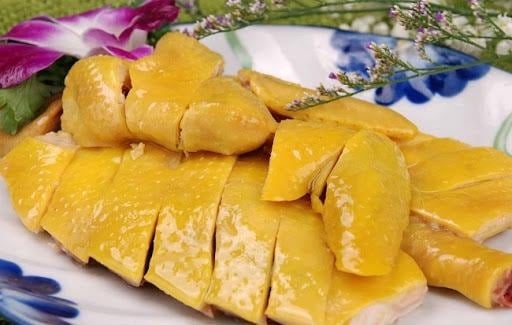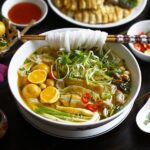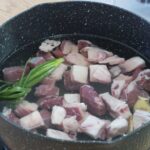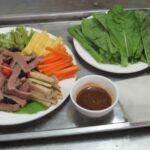Choosing the Right Chicken
When it comes to selecting a chicken, always opt for a free-range or organic option. If you decide to purchase a live chicken, pay close attention to its overall health. Indicators of a healthy chicken include glossy feathers, bright-colored plumage, a firm body, a large tongue root, and most importantly, bright eyes.
For pre-slaughtered chickens, look for those with a natural, pale yellow skin and even thickness. Also, take note of the meat’s elasticity, the evenness of the crop, and minimal accumulation of yellow fat around the neck and thighs. Avoid industrial chickens as their meat tends to be soggy, tasteless, and lacking in flavor. To ensure food quality, always prioritize free-range or backyard chickens.

Always opt for free-range or organic chickens for the best quality and flavor.
Preparing and Cooking the Chicken
For a meal, choose a hen as they have smaller bones, white meat, golden skin, and a sweet, aromatic flavor. After cleaning the chicken, remove the abdominal and neck fat for later use, such as stir-frying or storing.
Next, place the chicken in a pot for boiling, ensuring the water level covers the chicken. You can add dry onions, onions, or onion roots to the pot during boiling. If you plan to use the broth for soup, add a few slices of ginger, but be mindful not to overpower the flavor of other vegetables when cooking them together.
The Art of Boiling a Delicious Chicken
First, add 2 spoons of spices to the pot of water to create a balanced flavor, similar to when making soup. Place the pot on the stove and heat at a moderately high temperature.
Once the water boils, reduce the heat to low and continue simmering for 10 to 20 minutes, depending on the size of the chicken, before turning off the heat.
Then, let the chicken soak in the pot for about 30 minutes. Afterward, remove the chicken and rinse it under cold running water to achieve crispy skin. During this process, carefully remove any scum that forms on the chicken’s skin and drain the water.
While boiling the chicken, you can also separate the fat from the abdomen and neck for later use.
Why Boil Chicken in Hot Water?
Boiling chicken in hot water is more challenging than using cold water, as it requires careful timing and technique. This method helps retain the nutrients within the chicken, resulting in sweeter meat. Conversely, boiling in cold water can lead to nutrient breakdown due to prolonged cooking times.
A Step-by-Step Guide to Boiling Chicken in Hot Water
First, boil a moderate amount of water with dry onions, crushed ginger, and a little seasoning or salt. Then, dip the chicken in the boiling water 2-3 times to acclimatize it to the temperature before placing it in the pot, ensuring the thighs are facing down as they take the longest to cook.
Achieving that Golden, Attractive Chicken Skin
To give your chicken a golden, attractive skin, follow these simple steps:
First, after frying the chicken fat, take about 20-30ml of the liquid fat and mix it with turmeric. This is the secret to achieving that beautiful golden color in the chicken’s skin after boiling.

Mixing chicken fat with turmeric is the key to achieving golden, attractive skin.
If using fresh turmeric, finely chop the root and mix it with the chicken fat in a pan. Heat this mixture for about 30 seconds to a minute, then turn off the heat and use this fat to baste the chicken. If you’re using powdered turmeric, place it in a small bowl and pour the hot liquid fat from the pan into it, stirring well.
Allow the turmeric fat to settle without heating to avoid an overpowering turmeric aroma. Once the fat has settled, use it to baste the chicken. This process ensures golden skin without compromising the flavor.
For a beautiful meat texture, let the chicken cool completely before carving. You can place it in the refrigerator for 30 minutes to an hour before cutting. The chicken fat can also be used for stir-frying vegetables or cooking sticky rice, adding a delicious aroma and flavor.
To achieve a bright, smooth, and golden chicken skin, immediately after boiling, soak the chicken in hot or cold water to cool it down. Wait for the chicken to cool completely before plating. Skipping this step may result in dry skin that loses its appealing color.
Finally, to keep the meat moist, grate a thumb-sized piece of turmeric and extract its juice. Mix this juice with the previously fried chicken fat, then baste the chicken’s skin.
The result will be a beautifully boiled chicken with glossy, golden, and smooth skin. Good luck, and we hope you succeed in cooking a delicious and visually appealing boiled chicken dish!
“The Great Pork Conundrum: Cold or Hot Water for the Perfect Chần?”
“When it comes to creating delectable pork dishes, blanching the meat is a crucial step that cannot be overlooked. But the question remains – should you use hot or cold water for this process? Getting this step right is essential to ensuring your pork is not only free from any unpleasant odors but also remains moist and tender during cooking. Many home cooks and chefs alike have grappled with this very dilemma, striving to perfect their pork preparations.”




































